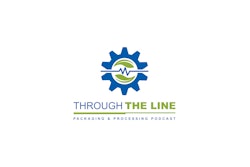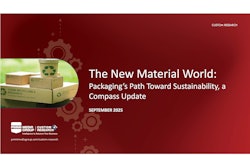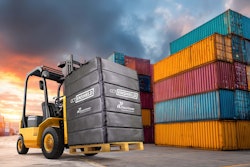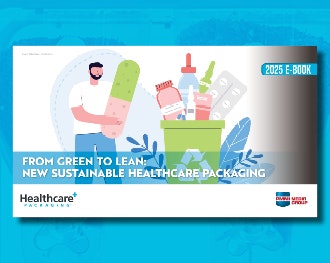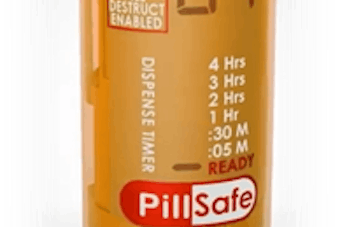Originally posted 11/28/2018
Only one in four manufacturers are fulfilling e-commerce in-house, while another 40% are using 3PL warehouses, according to a new report from PMMI Business Intelligence.
Sixty-five percent of respondents are using etailers to market their products, with 54% reporting selling through Amazon. Thirty-three percent are selling direct to consumer.
“We would need to develop new ways of distribution for e-commerce products,” said one Packaging Engineer from a nutraceuticals company.
“Our supply chain is for high speed mass production and e-commerce requires customization to meet delivery demands,” said one Packaging Manager, for an industry-leading CPG.
3PL companies interviewed predict their businesses to grow, on average, by 31% in the next two years. Growth fueled by the rise of e-commerce.
Every logistics supplier is looking for technology advancements to meet the challenges of e-commerce. Forty-four percent of logistics suppliers reported using wearable technology to improve pick and ship accuracy and authenticate the product.
Bringing fulfillment in-house would require more automation. “Bringing e-commerce fulfillment and shipping in-house would require sufficient quantities, enough for high speed automation,” said a Sr. Specialist, Engineering, for an over-the-counter drug manufacturer.
“Bringing e-commerce fulfillment in house would be done to achieve greater cost effectiveness,” said a Sr. Packaging Engineer for a consumer goods operation.
Another option is having Amazon right in your own plant handling fulfillment. “Amazon is inside our operations now and have a spot they use for collating products and shipping. They are a critical partner and know e-commerce will spike within the next 10 years,” offered one CPG product manager.
There are pros and cons to handling fulfillment in-house or outsourcing to a 3PL.
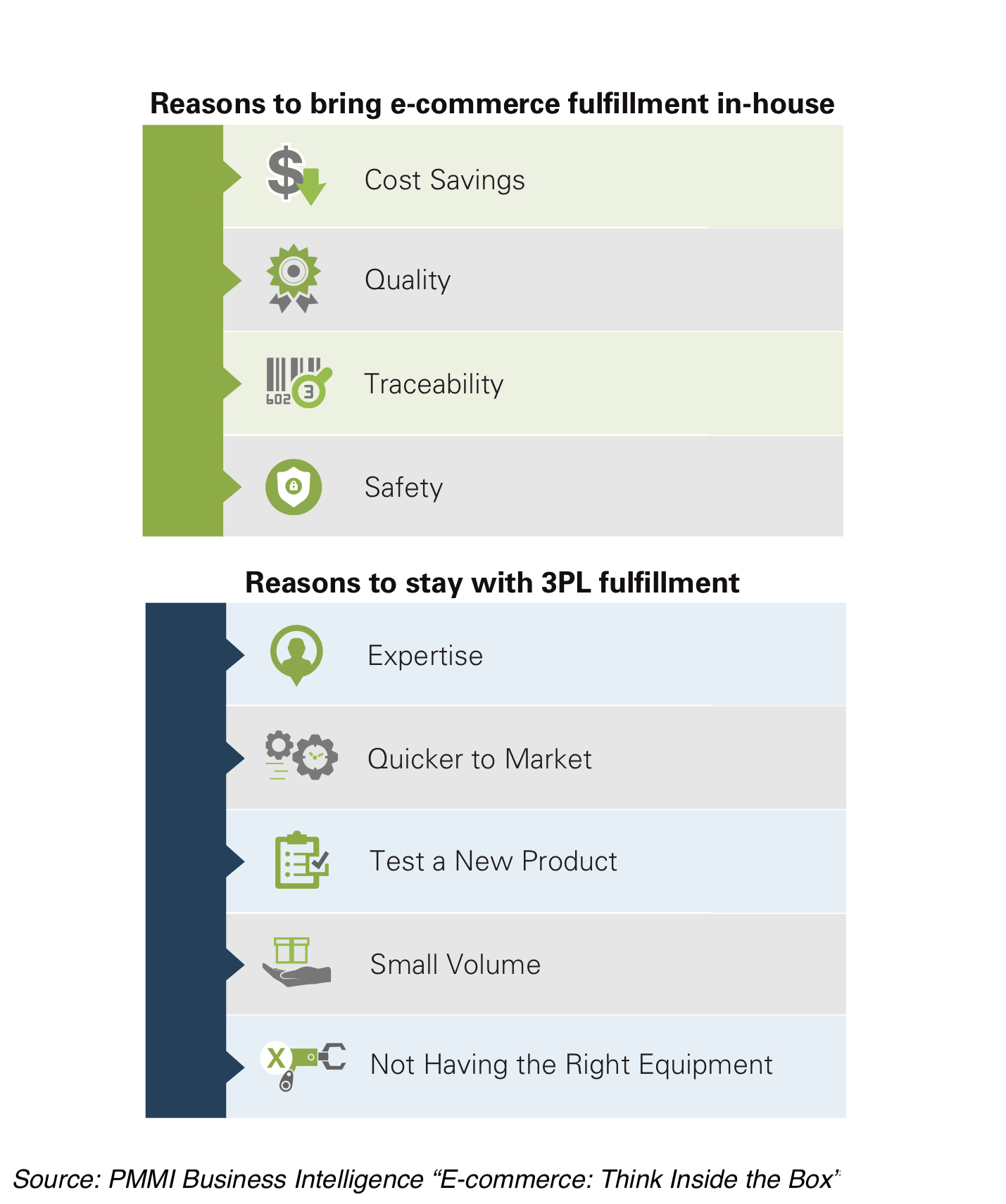
For more information on how e-commerce is impacting CPGs, 3PLs and packaging OEMs, download the FREE Executive Summary below. PMMI members can access entire 56-page report here.
To see all ten articles in this series, click here.
Originally posted 11/28/2018
Only one in four manufacturers are fulfilling e-commerce in-house, while another 40% are using 3PL warehouses, according to a new report from PMMI Business Intelligence.
Sixty-five percent of respondents are using etailers to market their products, with 54% reporting selling through Amazon. Thirty-three percent are selling direct to consumer.
“We would need to develop new ways of distribution for e-commerce products,” said one Packaging Engineer from a nutraceuticals company.
“Our supply chain is for high speed mass production and e-commerce requires customization to meet delivery demands,” said one Packaging Manager, for an industry-leading CPG.
3PL companies interviewed predict their businesses to grow, on average, by 31% in the next two years. Growth fueled by the rise of e-commerce.
Every logistics supplier is looking for technology advancements to meet the challenges of e-commerce. Forty-four percent of logistics suppliers reported using wearable technology to improve pick and ship accuracy and authenticate the product.
Bringing fulfillment in-house would require more automation. “Bringing e-commerce fulfillment and shipping in-house would require sufficient quantities, enough for high speed automation,” said a Sr. Specialist, Engineering, for an over-the-counter drug manufacturer.
“Bringing e-commerce fulfillment in house would be done to achieve greater cost effectiveness,” said a Sr. Packaging Engineer for a consumer goods operation.
Another option is having Amazon right in your own plant handling fulfillment. “Amazon is inside our operations now and have a spot they use for collating products and shipping. They are a critical partner and know e-commerce will spike within the next 10 years,” offered one CPG product manager.
There are pros and cons to handling fulfillment in-house or outsourcing to a 3PL.

For more information on how e-commerce is impacting CPGs, 3PLs and packaging OEMs, download the FREE Executive Summary below. PMMI members can access entire 56-page report here.
To see all ten articles in this series, click here.
Originally posted 11/28/2018
Only one in four manufacturers are fulfilling e-commerce in-house, while another 40% are using 3PL warehouses, according to a new report from PMMI Business Intelligence.
Sixty-five percent of respondents are using etailers to market their products, with 54% reporting selling through Amazon. Thirty-three percent are selling direct to consumer.
“We would need to develop new ways of distribution for e-commerce products,” said one Packaging Engineer from a nutraceuticals company.
“Our supply chain is for high speed mass production and e-commerce requires customization to meet delivery demands,” said one Packaging Manager, for an industry-leading CPG.
3PL companies interviewed predict their businesses to grow, on average, by 31% in the next two years. Growth fueled by the rise of e-commerce.
Every logistics supplier is looking for technology advancements to meet the challenges of e-commerce. Forty-four percent of logistics suppliers reported using wearable technology to improve pick and ship accuracy and authenticate the product.
Bringing fulfillment in-house would require more automation. “Bringing e-commerce fulfillment and shipping in-house would require sufficient quantities, enough for high speed automation,” said a Sr. Specialist, Engineering, for an over-the-counter drug manufacturer.
“Bringing e-commerce fulfillment in house would be done to achieve greater cost effectiveness,” said a Sr. Packaging Engineer for a consumer goods operation.
Another option is having Amazon right in your own plant handling fulfillment. “Amazon is inside our operations now and have a spot they use for collating products and shipping. They are a critical partner and know e-commerce will spike within the next 10 years,” offered one CPG product manager.
There are pros and cons to handling fulfillment in-house or outsourcing to a 3PL.

For more information on how e-commerce is impacting CPGs, 3PLs and packaging OEMs, download the FREE Executive Summary below. PMMI members can access entire 56-page report here.
To see all ten articles in this series, click here.
Originally posted 11/28/2018
Only one in four manufacturers are fulfilling e-commerce in-house, while another 40% are using 3PL warehouses, according to a new report from PMMI Business Intelligence.








